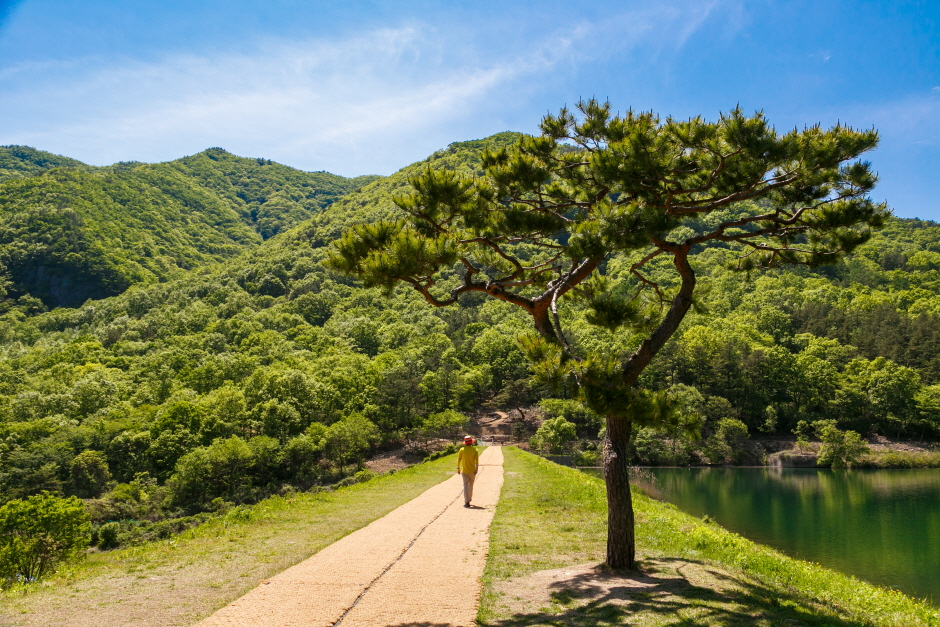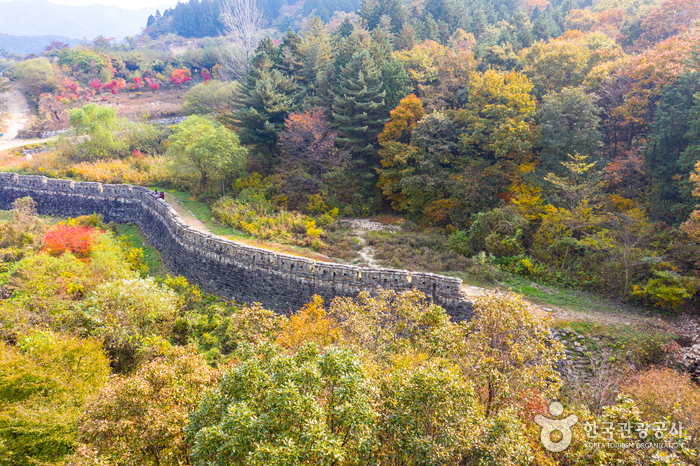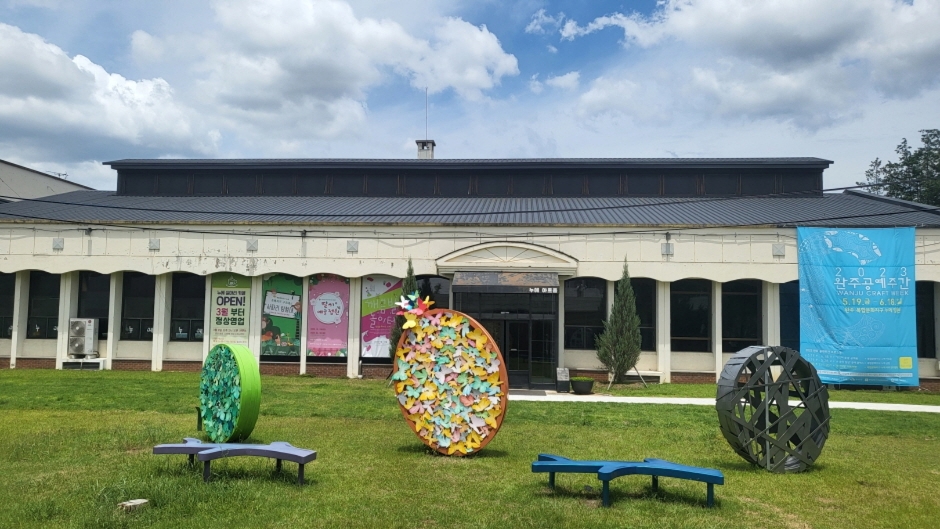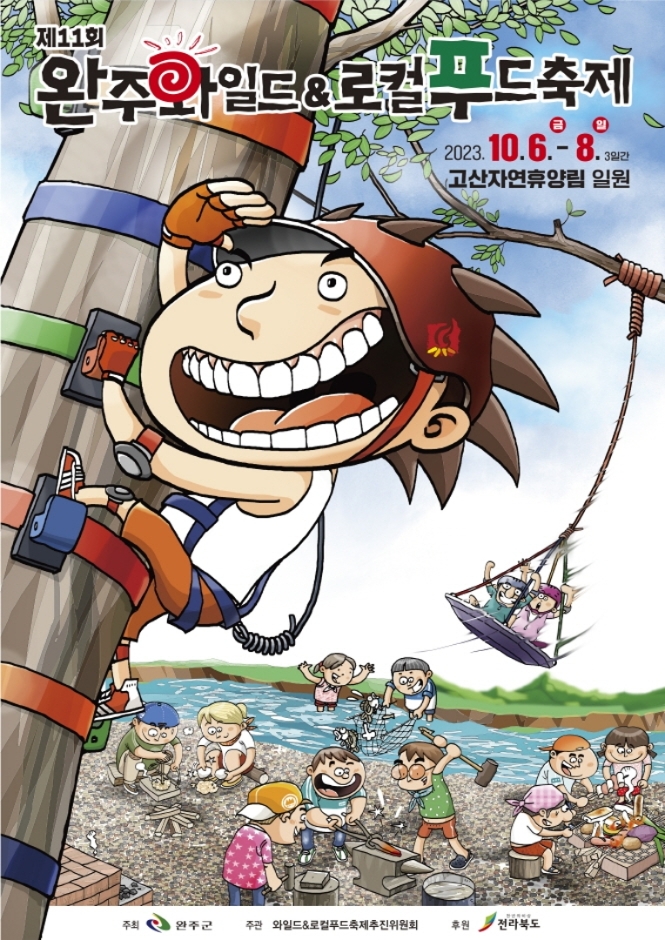Happydream [Korea Quality] / 행복드림한옥 [한국관광 품질인증]
0m 9895 2024-04-07
181-21, Bongseoan-gil, Yongjin-eup, Wanju-gun, Jeonbuk-do
+82-10-3677-5339
The Dueok Happy Dream Village Farming Association Corporation runs a hanok-style guesthouse situated in Dueok Happy Dream Village, which is surrounded by high, clean mountains. Also known as Bongseogol, the village is a pleasant farming community located deep in the lush green mountains of Wanju-gun, Jeollabuk-do, and is also well known as one of the eight best propitious sites in Korea – Jongnamsan Mountain on its right and Seobangsan Mountain on its left are said to resemble a phoenix('Bonghwang' in Korean) embracing the village (hence the name of the village is ‘Bongseo’).
Dueok Village was re-born as Dueok Happy Dream Village as part of the rural village revitalization project carried out in Wanju County. The village has jointly run diverse hanok buildings (ranging from about 45 to 150 years old) as hanok-style guesthouses, along with various hands-on programs, since 2010. The Dueok Happy Dream Village Farming Association Corporation now runs the guestrooms and a large experience center, and only accepts groups of guests. The experience center offers education programs on traditional etiquette, and also operates reenactments of the ancient civil service examination. It also offers guests three good meals a day consisting of rural-style healthy food served with wild vegetables and various side dishes at a reasonable price.
The guesthouse comprises tile-roofed houses on both sides set amid a large grassy field against a background of green mountains. The guestrooms feature a simple yet pleasant design and are equipped with ondol (under-the-floor heating) without air-conditioning. The experience center is notable for its ten doors which can be opened by lifting them up toward the ceiling, thereby providing an open view of the beautiful landscape.
Furthermore, the village, which has been designated as a rural experience and recreational village, runs a wide variety of hands-on programs, including a Nature Experience program consisting of a forest tour with a guide, Making a Wish Necklace, Walking on the Myeongdang (propitious site), Rice Farming, Digging Sweet Potatoes, Traditional Folk Games (archery, steel hoop rolling), Rice Cake Pounding, Making Scarecrows, and Making a Kite, among others. It also offers Sori Hakdang and etiquette education programs as a two-day course.
Embalse Oseongje (오성제 저수지)
2.7 Km 1 2024-04-07
Daeheung-ri, Soyang-myeon, Wanju-gun, Jeonbuk-do
Ubicado en la zona de Soyang-myeon, distrito de Wanju-gun, provincia de Jeollabuk-do, este embalse está rodeado de un precioso paisaje natural y sus senderos de paseo lo convierten en un espacio ideal para la relajación. En 2019, el grupo BTS visitó el lugar para el programa “2019 BTS SUMMER PACKAGE” y lo hizo famoso como destino turístico.
NocWoonJae [Korea Quality] / 녹운재 [한국관광 품질인증]
2.9 Km 6131 2024-04-07
472-18, Songgwangsuman-ro Soyang-myeon, Wanju-gun, Jeonbuk-do
+82-10-4450-6565
'As a traditional Korean house with floor area of 99m², Nocwoonjae has been in business since 2014 in Oseong Hanok Village, Wanju-gun, Jeollabuk-do. The name 'Nocwoonjae' means 'a house with a green cloud hanging over it' in Korean. It was named as such because of the green broad-leaved and coniferous trees along the foot of the mountain in the vicinity of the guesthouse. The entrance way is lined with flowers and trees, leading to two Korean houses connected by an open hallway. The guesthouse is owned by two sisters who built this place after staying at many of the popular 'hanok (traditional Korean house)' guesthouses in other parts of the country. It was a dream come true for them, so they did everything in their power to make their place perfect by choosing the building materials themselves, even the tiles. Because the exterior walls are made of red clay and tiles, it's cool in summer and warm in winter. There is also a large wooden floor hall where guests can enjoy the nature. The rooms are decorated with embroidered cotton sheets and antique furniture. Both of the sisters are amateur oriental painters specializing in painting the 'Four Gracious Plants (Plum, Orchid, Chrysanthemum, and Bamboo)', so they even made the lamps with traditional Korean paper with their paintings on them. Indeed, they did everything they could to make this place as pretty as possible.
The two traditional Korean houses named Naunchae and Unachae are built on a natural slope without harming the nature. The two houses are connected by a hallway with windows, so guests can sit on the staircase to enjoy the view outside. The 'Naunchae,' which means 'silky cloud' in Korean, consists of a room, an attic, a kitchen, a hall, and a bathroom. From the attic, you can have a great view of the trees and pine grove through the window. Right behind the house are the strawberry garden and stone walls for the guests to relax. The walls and floor of the room are made of red clay and natural wood with a pleasant natural aroma, which is good for the mind and body. The kitchen walls are made of colorful tiles and wood, with a large window right next to it offering a great view of the pine grove. In the main hall, guests can throw open the large window and lay on the wooden floor to look at the nature and enjoy the breeze.
The 'Unachae,' which means 'beautiful cloud' in Korean, consists of tea room, guestroom, kitchen, hall, and bathroom. It's very similar to the 'Naunchae,' except for the long window next to the kitchen and a table underneath it. The guesthouse sometimes offers special discounts, so be sure to ask about them when booking a room.
There are different types of flowers in the front yard, including cosmos, rose moss, and cockscomb. The sisters also grow corn, sorghum, strawberries, persimmon, jujube, and plum trees there. In the harvest season, guests can pick and try the fruits and vegetables. The sisters also offer a number of experience programs, such as Oriental painting class where you can grind the ink stick and paint the Four Gracious Plants on traditional Korean paper and tea class where you can try the tea made of the persimmon leaves and flowers grown by the owners. Breakfast includes toast, jam, and milk. There is a kitchen, so you can cook whatever you want. Popular tourist destinations in the vicinity of the guesthouse include Songgwangsa Temple and Wibongsa Temple as well as the 60m-high Wibong Falls, one of the Eight Views of Wansan Mountain. Jeonju Hanok Village is a 20-minute ride from the guesthouse.
Aldea Tradicional Oseong (오성한옥마을)
3.0 Km 1 2024-04-06
Daeheung-ri, Soyang-myeon, Wanju-gun, Jeonbuk-do
Rodeada por los montes Jongnamsan y Wibongsan, la Aldea Tradicional Oseong cuenta con unas 20 casas al estilo hanok en un envidiable entorno natural. Se trata de un área residencial real, con instalaciones como cafeterías, galerías y senderos forestales, perfectos para experimentar de cerca la cultura tradicional coreana. Entre sus lugares predilectos está la Casa Awon, que apareció en el programa “2019 BTS SUMMER PACKAGE”. En particular, el sitio ganó popularidad luego de la visita del grupo BTS al embalse Oseongje y a la fortaleza Wibongsanseong. La Casa Awon originalmente estaba en la ciudad de Jinju, en la provincia de Gyeongsangnam-do, pero fue trasladada a su ubicación actual, en la Aldea Tradicional Oseong. Construida hace unos 250 años, es un testimonio perfecto de la vida cotidiana de los eruditos durante la dinastía Joseon.
Fortaleza Wibongsanseong (위봉산성)
3.8 Km 24445 2024-04-06
Daeheung-ri, Soyang-myeon, Wanju-gun, Jeonbuk-do
Esta fortaleza fue completada en 1675, el primer año de reinado de Sukjong (1674-1720), de la dinastía Joseon. Tenía un propósito defensivo o para uso en emergencias, como depósito eventual del retrato del rey Taejo (fundador de la dinastía), que se guardaba en el santuario Gyeonggijeon de Jeonju, en caso de necesidad. De hecho, eso tuvo que hacerse durante la Rebelión Campesina Donghak de 1894, que ocupó la ciudad de Jeonju. La muralla original de la fortaleza tenía entre 4 y 5 metros de altura, 3 metros de ancho y una extensión de 16 km, junto con tres puertas principales (la del Este, la del Oeste y la del Norte). Solo el arco de piedra de la Puerta del Oeste permanece en pie. En los alrededores de la fortaleza también se encuentran el templo Wibongsa y las cascadas Wibong, que son uno de los 8 Paisajes de Jeonju.
Espacio Abierto Nu-e (복합문화지구 누에)
4.4 Km 0 2024-04-06
Wanju-ro 462-9, Wanju-gun, Jeonbuk-do
Festival Wild & Local Food de Wanju (완주 와일드&로컬푸드축제)
6.6 Km 21312 2024-04-06
Gosanhyuyangnim-ro 246, Wanju-gun, Jeonbuk-do
063-290-3976
El Festival Wild & Local Food de Wanju busca dar a conocer la ciudad de Wanju, donde se puede realizar el cheollyeop (pesca en río), y conocer la vida silvestre coreana y sentir la nostalgia del pasado. El evento también provee la oportunidad de probar comida natural con productos agrícolas locales, y también una amplia variedad de plantas y animales de Wanju. Este festival tiene el propósito de ofrecer a los visitantes un sentimiento de nostalgia por la comida del pasado a través de diferentes programas y rodeados de la naturaleza.
Bosque Recreativo de Gosan (고산자연휴양림)
6.7 Km 106892 2024-04-06
Gosanhyuyangnim-ro 246, Gosan-myeon, Wanju-gun, Jeonbuk-do.
El Bosque Recreativo de Gosan, situado en la aldea Osan-ri de Gosan-myeon, es un popular destino familiar durante todo el año. Repleto de densos bosques de pinos blancos y de otras especies, este bosque ofrece un lugar de descanso fresco en verano, gracias también a los muchos arroyos que lo surcan. En otoño, toda la zona se transforma en un arco iris de brillantes tonos amarillos, rojos y naranjas. Al llegar el invierno, la nieve cubre los árboles y el terreno, convirtiendo el bosque en un vasto infinito blanco. Con la primavera, florecen las azaleas y los cerezos, siendo entonces un lugar muy popular entre las parejas jóvenes.
Zoológico de Jeonju (전주동물원)
8.0 Km 26957 2024-04-06
Sori-ro 68, Deokjin-gu, Jeonju-si, Jeonbuk-do.
Localizado a 1.000 metros del Parque Deokjin en el distrito Deokjin-gu de Jeonju, el zoológico no solamente cuenta con una diversidad de animales y plantas, sino un campo de fútbol, cancha de vóleibol y otros espacios para practicar deportes. Además, el parque de atracciones DreamLand se encuentra en el lado este del zoológico. Abierto el 10 de junio de 1978, los visitantes pueden ver allí tigres, leones, jirafas, hipopótamos, vacas, rinocerontes, camellos y otros animales exóticos.
Centro Cultural Sori de Corea (한국소리문화의전당)
8.3 Km 9575 2024-04-06
Sori-ro 31, Deokjin-gu, Jeonju-si, Jeonbuk-do.
La ciudad de Jeonju se caracteriza por su hermosa historia y cultura. Los habitantes de Jeonju sienten una gran pasión por el arte, y aquí se encuentran muchos artesanos de renombre y de mucho potencial. El Centro Cultural Sori de Corea refleja bien el espíritu artístico y cultural de la región, y sirve como agradable punto de reunión para todos los que la visitan.
![Happydream [Korea Quality] / 행복드림한옥 [한국관광 품질인증]](http://tong.visitkorea.or.kr/cms/resource/23/2576423_image2_1.jpg)

![NocWoonJae [Korea Quality] / 녹운재 [한국관광 품질인증]](http://tong.visitkorea.or.kr/cms/resource/71/2049271_image2_1.jpg)




 Español
Español
 한국어
한국어 English
English 日本語
日本語 中文(简体)
中文(简体) Deutsch
Deutsch Français
Français Русский
Русский